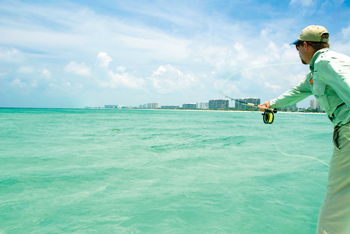Anatomy of a fishing rod

rUSTY CHINNIS | sun
When the action gets hot, you want the best rod you can afford.
Every fisherman’s rod, be it a spinning rod, a fly rod or a casting rod, is constructed in a similar way and has the same basic parts. Have you ever wondered why one rod is more expensive than another and why? Here is a breakdown of the basic components of a fishing rod that should help you understand their construction, and why one rod costs more than another. This should also help you determine which rod is best for you.
A rod’s blank is constructed from a product known as prepreg. This material is impregnated with resin and wrapped around a mandrel, which is removed after the blank is formed, giving the rod its basic round shape. This blank holds the guides, ferrules, handle, reel seat and fighting butt.
Prepreg has fibers that have a unidirectional (straight) orientation. The fibers can be made of different materials including fiberglass, graphite, boron or Kevlar. Some rods are made (laid up) from a prepreg that has additional fibers that run around or at an angle to the unidirectional fibers. This gives the rod additional strength and influences flex, stiffness and affects its price.
A rod’s scrim refers to a light weight material that forms an additional lining under the primary fibers and helps in working the material when it is wrapped around the mandrel. Scrim can be straight or woven and adds what is known as hoop strength to the finished rod.
The parts of a rod consist of a blank with a butt section, a fixed hood, a reel seat, a sliding hood, a locking ring, handle, guides, ferrules and a tip. The butt section is the cork part of the rod behind the reel seat that fits into a fighting harness or into the stomach when playing a fish. On a spinning and casting rod, it’s where the non-dominant hand holds the rod. The reel seat is where the reel foot is placed either on or near the blank, while the hoods secure the reel to the rod. The fixed hood is the metal receiver where one end of the reel foot is placed. The sliding hood is the rear receiver that holds the other end of the reel foot. The locking ring is a nut that puts pressure on the sliding hood and holds the reel securely in place. The handle is the cork where the dominant hand is placed. The guides hold the line along the length of the blank. The ferrules connect sections of a rod. The tip as the name implies is the section at the top of the rod.
You may also have heard the term taper. A rod’s taper refers to the diameter of a rod from the butt to the tip. The taper effects the rod’s action. Most rods have either a fast action (stiff) or a slow action(flexible).
When you’re shopping for a new outfit, knowing the parts and construction of a rod will help you make an informed decision. The most important part of the rod and the one that most affects its price and your buying decision is the blank. The materials and the method of construction of the blank determines its price. The least expensive rods are made from fiberglass, while the expensive ones are constructed with graphite, boron and Kevlar. While fiberglass may be good for a beginner, the more expensive rods are a better choice for the seasoned angler. Armed with this information, you’ll have the knowledge you need to determine how much you spend on a rod. This decision can positively affect your angling efficiency and enjoyment.

